Walmart Pay
Enabling seamless in-store payments with the first platform-agnostic mobile payment solution
Walmart Pay enables customers to pay in the store with their smartphones using the Walmart mobile app. It works with any iOS or Android device, at any checkout lane, and with any major credit, debit, pre-paid or Walmart gift card in their account.
Walmart was the first retailer to offer its own mobile payment solution. Walmart Pay piloted in December 2015 and was released to chain (4,620 stores) in June of 2016. In July of 2018, it had close to 4 million unique users and was close to surpassing Apple Pay in usage for mobile payments.

PROBLEM:
Our product team was issued a challenge from the business: Make Walmart the first retailer to offer its own mobile payment solution. This was tricky for several reasons that came up over the course of the project:- The product & engineering teams working on customer and Associate-facing software had never worked together to launch an omnichannel feature of this size.
- The point of sale hardware in stores couldn't be changed—so our product solution would need to work within the limitations of the existing PINpad at checkout (ex: Associates would not be able to scan a barcode on the customer’s phone).
- And our biggest experience challenge: The core mobile customer wasn’t the early adopter type (and was wary of doing anything related to payments on their mobile phone).
MY ROLE:
UX Strategy, Interaction Design, Information ArchitectureI led the design effort for Walmart Pay on our iPhone and Android apps. I co-developed the Walmart Pay value proposition and a key product-led growth strategy for customer acquisition, served as the principal Information Architect and Interaction Designer, and managed the entire mobile UX team's process and workflow—leading a team consisting of a visual designer, content strategist, prototyper and user researcher.
I drove the mobile product team to connect with cross-functional marketing and development teams (Android, iOS and point of sale software) to deliver the best possible Walmart Pay in-store customer experience on our apps, in our signage, and at the point-of sale. I also played a key role in demoing the feature to Walmart executives in Bentonville, AR and achieving a green light to move forward on the project as a result.
IMPACT:
- Shortly after launch, Walmart Pay had more than 1 million unique users (most of them Savings Catcher users acquired via our product-led growth strategy). One year later, usage had increased by 4x and was close to surpassing Apple Pay in usage for mobile payments. It is still the only mobile payment method accepted in Walmart stores.
- In-app ratings (2017): Four out of five users said they would recommend Walmart Pay and three out of four gave the solution a five-star rating.
- We were granted a design patent (us D820,850) for our payment drawer design.
How might we create a platform-agnostic mobile payment solution that works with existing point of sale hardware in Walmart stores AND give not-so-tech-savvy customers the incentive and reassurance they need to start using their phones to pay in the store?
PROCESS:
Solving this problem involved collaborating across technology, business and marketing teams in a way that nobody had done before at Walmart.Discovery: Competitive Analysis & Early Technical Prototypes
I kicked off the project in May 2015 by leading the mobile UX team through a competitive analysis of other companies pursuing mobile payment.
At the same time, I collaborated with engineering to help the team create several low-fidelity prototypes based on the business and technical requirements to vet the mobile/POS pairing process (creating wireframes exploring several options for pairing). We confirmed at this point that our product team’s preferred solution (Store Associate scans a barcode on the customer’s phone) would not be feasible due to hardware and budget constraints, and moved forward with an alternate flow: the customer would scan a QR code displayed on the PINpad at checkout.
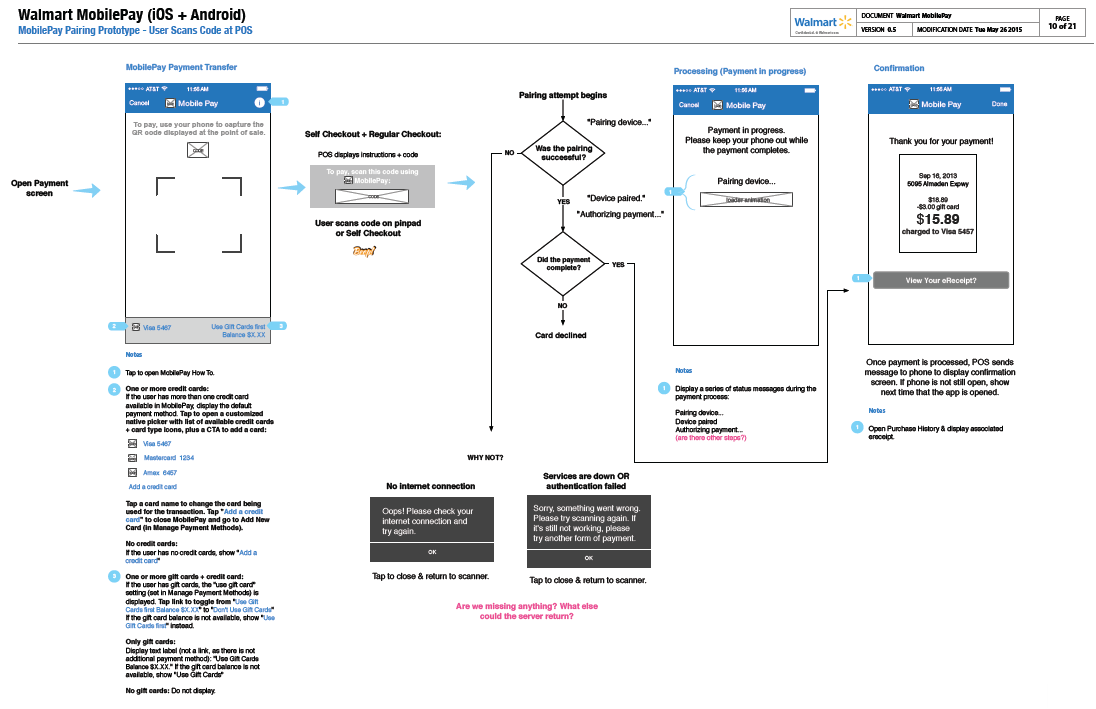
Flow for early low-fi prototype used to prove out the technical solution behind Walmart Pay.
Defining the Experience: Storyboarding to Unblock Other Teams
To begin defining the high-level customer experience, I created storyboards to communicate the overall customer experience to stakeholders and to unblock cross-functional partners (engineering and marketing teams), so that they could continue to move forward in their work without needing detailed wireframes.
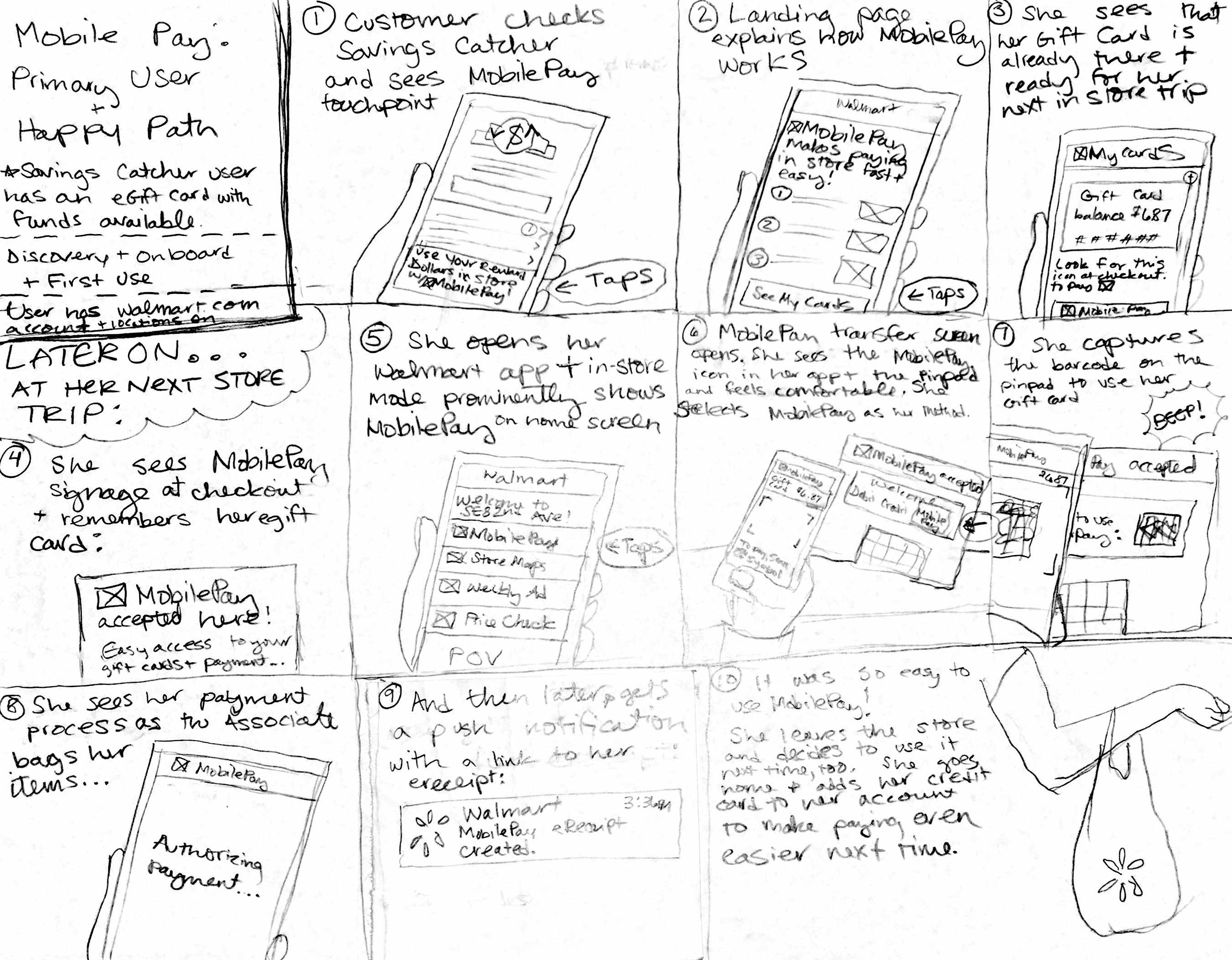
Early Walmart Pay customer experience storyboard.
Product-led Growth Strategy: Customer Acquisition and Value Proposition
With the technical solution and the high-level Walmart Pay experience defined, we still had a problem: Our core mobile customers were not early adopters, and were unlikely to use mobile payment without some kind of incentive. How would we attract Walmart Pay’s first users?
I collaborated with my research partner to synthesize customer persona research with business goals in order to define Walmart Pay’s value proposition and target personas, and to brainstorm a customer acquisition strategy for the feature.
We identified a product-led growth opportunity for Walmart Pay: Many of our target mobile app users were Savings Catcher users, and had Savings Catcher reward dollars saved in the form of virtual Walmart gift cards in their app, but no way to easily use them in the store.
Our hypothesis: By promoting Walmart Pay within Savings Catcher and then supporting gift cards as a payment method within Walmart Pay, we would entice customers to easily give Walmart Pay a try for the first time, using those gift cards.
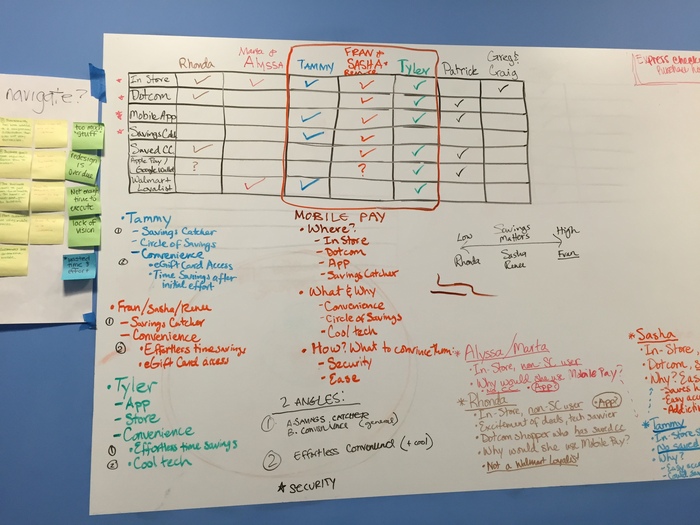
Mapping personas to attributes & motivations.
Defining the Details: Wireframes and Prototyping
Our challenge now was to design a simple, low-friction experience. I created detailed wireframes and steered the UX team's creation of visual design, content strategy and web-based prototypes for early usability testing. I also collaborated with Walmart’s marketing team and the ISD point-of-sale engineering team to ensure a consistent experience across customer and Associate-facing touch points.



Detailed cross-platform wireframes describing the various states for the Walmart Pay drawer screen.
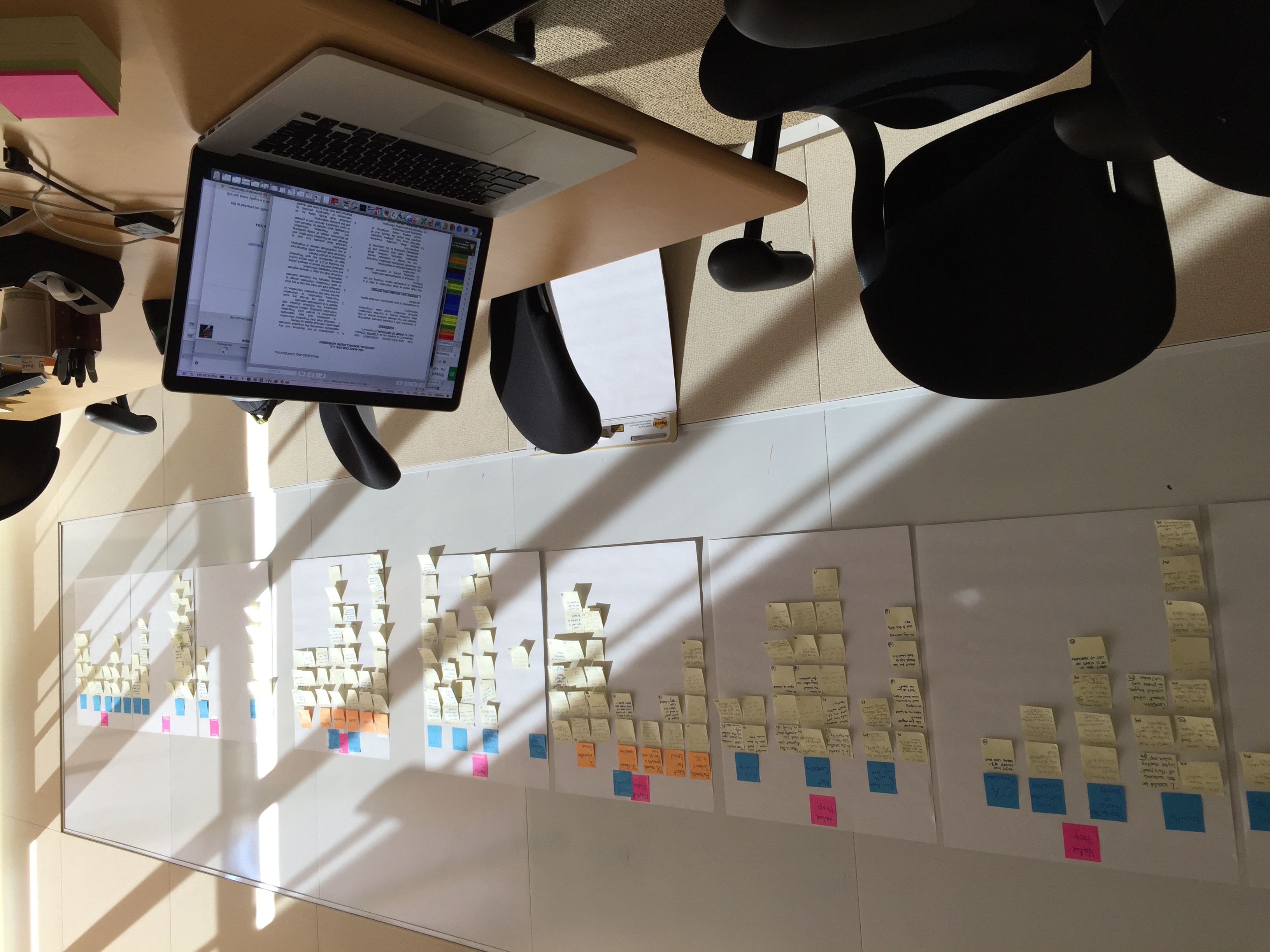
Walmart Pay research lab study.
Usability Testing & Stakeholder Alignment
In August, we tested the signup and in-store payment experience with customers in a user research lab study.
Based on our research findings, we iterated to improve the experience (streamlining the signup flow and tweaking language & imagery). In September, we used this same web prototype to gain sign off on the project from Walmart executives during demo week (in a secret lab!) in Bentonville, AR, where I co-presented a demo of the end-to-end, cross-channel customer experience, alongside our stakeholders.
In August, we tested the signup and in-store payment experience with customers in a user research lab study.
Based on our research findings, we iterated to improve the experience (streamlining the signup flow and tweaking language & imagery). In September, we used this same web prototype to gain sign off on the project from Walmart executives during demo week (in a secret lab!) in Bentonville, AR, where I co-presented a demo of the end-to-end, cross-channel customer experience, alongside our stakeholders.
Walmart Pay Pilot + Field Usability Testing
We spent the rest of the fall getting the Android and iPhone app experiences ready for launch, moving towards the Walmart Pay pilot's December launch announcement date.
We piloted in a handful of stores, conducted several weeks of testing with customers in the field, and identified opportunities for improvement before launching chain-wide.
We spent the rest of the fall getting the Android and iPhone app experiences ready for launch, moving towards the Walmart Pay pilot's December launch announcement date.
We piloted in a handful of stores, conducted several weeks of testing with customers in the field, and identified opportunities for improvement before launching chain-wide.

Walmart Pay field usability testing.

Finalizing the Walmart Pay MVP
The final design shipped in May 2016:
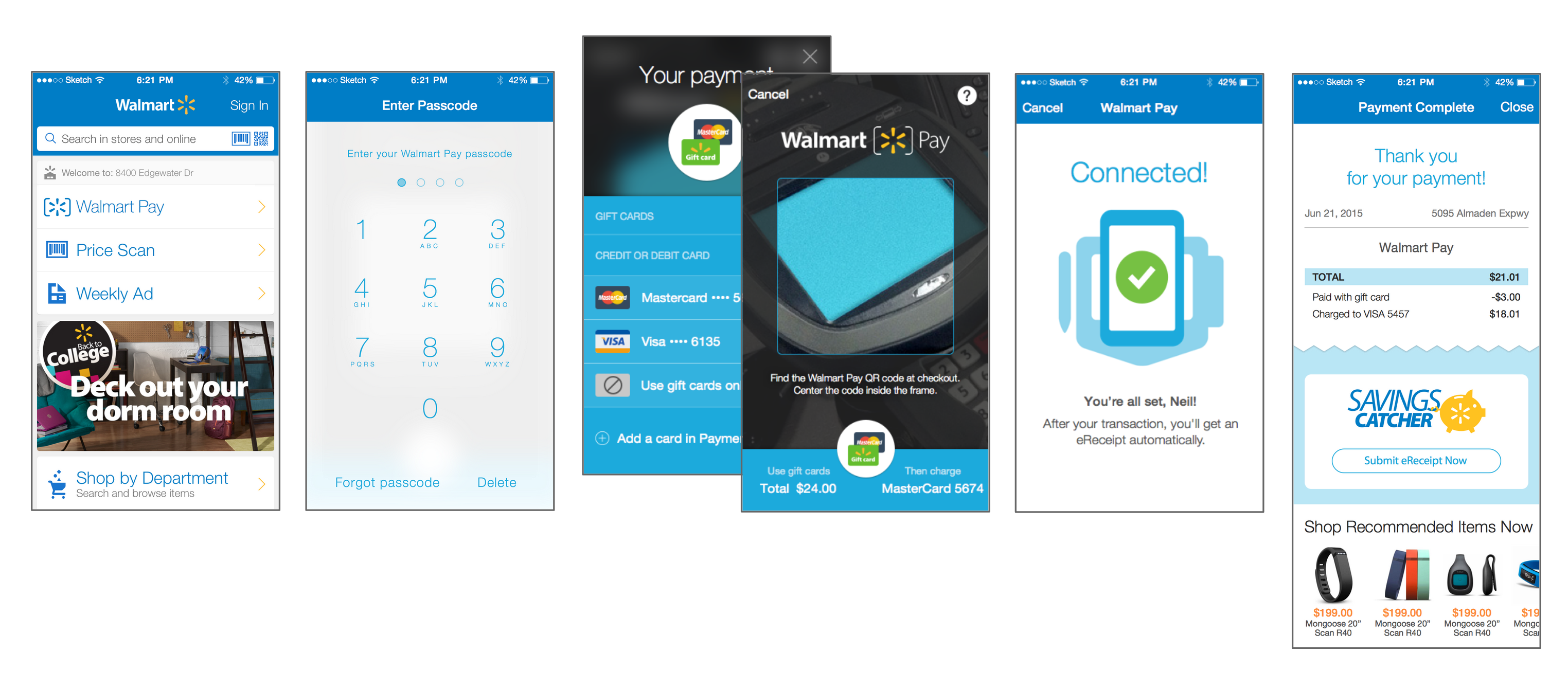

Payment flow; Savings Catcher gift card acquisition strategy.
RESULTS:
- In June of 2017, Walmart Pay had more than 1 million unique users (most of them Savings Catcher users acquired via our product-led growth strategy) and as of November 2017, was close to surpassing Apple Pay in usage for mobile payments.
- Repeat usage was huge: 88% of transactions came from repeat users:
“Nearly 50 percent (47.2 percent to be exact) of respondents who shop at Walmart said that they used it every time they could — only 6.6 percent said that they never thought to use it at all.” - In-app ratings (2017): Four out of five users said they would recommend Walmart Pay and three out of four gave the solution a five-star rating.
- The team was also granted a design patent (us D820,850) for our payment drawer design.
Walmart Pay demonstration video (2015).
Awards:
- Mobile Commerce Daily: 2015 Mobile Retailer of the Year first runner-up: Walmart
- Walmart Year Beginning Meeting 2016 - Team Innovation Award
- @WalmartLabs Q1 FY17 Shipped It Award
- Individually recognized with a quarterly "Spark Award" by my internal UX teammates for my role and efforts on the project.
Walmart Pay in the news:
Business Wire: Walmart Introduces Walmart Pay (2015)
New York Times: Walmart Prepares to Enter Mobile Payments Business (2015)
Forbes: Walmart Drops An Atomic Bomb On Its Apple Pay Competitor (2015)
Bloomberg: Walmart Pay Could Surpass Apple in U.S. Mobile Payments (2017)
Pymnts.com: What Walmart Pay Knows that Apple Pay Doesn’t (2017)
Download the Walmart app:
App Store
Google Play Store